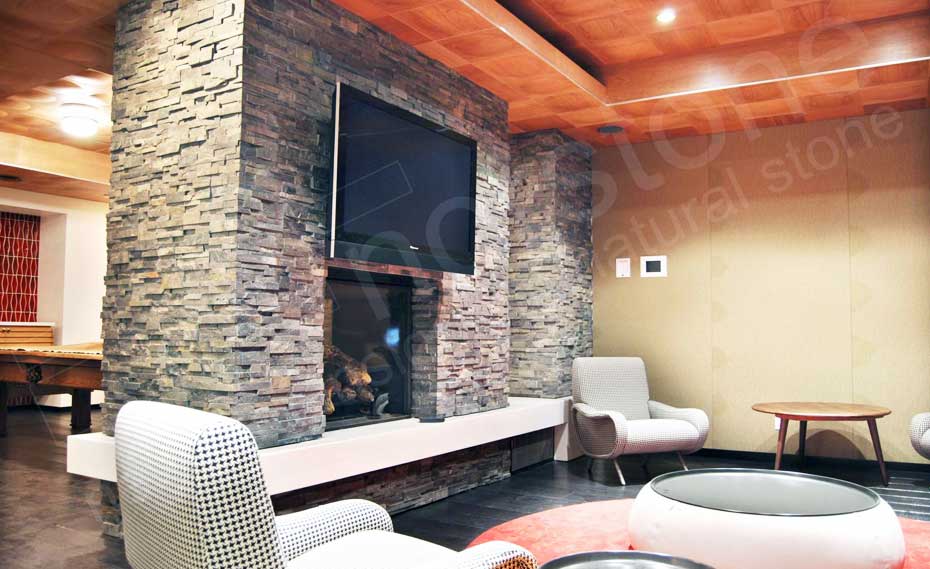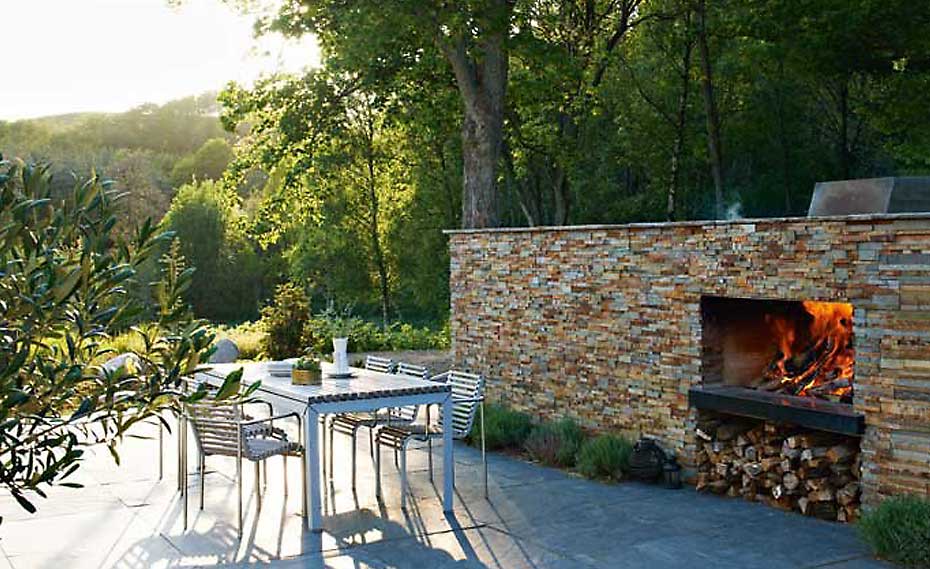Common Problems with Stacked Stone on a Fireplace and How To Fix Them
As the temperature drops outside this winter, more and more people will light up their beautiful stone fireplace for both warmth and ambiance. Fireplaces offer a great ROI for home renovation dollars, and we’ve sold sold our stacked stone panels to literally hundreds, maybe even thousands of fireplace projects since the mid 2000s, giving us a lot of experience in the design of these units, as well as their installation and operational maintenance.
Fireplaces are an integral part of any living space and natural stone veneer options are one of the best options when considering what to clad the fireplace in. Fireplaces span a wide range of styles, designs and applications, ranging from the traditional living room or den fireplace that is the focal point of the room, to long linear gas fireplaces in non traditional places like kitchens and small accent walls. Outdoor fireplaces, often part of a large outdoor kitchen / outdoor living space build out, are equal parts about creating warmth and promoting conversation. At Norstone we are known for our architectural grade natural stone panels which are designed to be installed easily over cementious substrates to create a stunning stacked stone fireplace. Specially designed details like our outside corner pieces make fireplace installations with these panel systems a breeze. While installation will be easier than expected, with use and over time there are some common problems that can crop up with a natural stone fireplace.
From a stone standpoint, there’s two main areas of concern that our clients occasionally see – discoloration of the stone over time and the stone itself heating up to the touch. Let’s take a look at what causes each of these and the best way to fix them.
Discoloration on the stacked stone face of a fireplace is almost always caused by a malfunctioning fireplace insert or improper use of a more traditional wood burning fireplace box. Wood smoke is a heavy carrier of natural carbon compounds that will easily attach themselves to the rough texture of a stacked stone wall in the form of soot. Even gas fireplaces, since most of them rely on natural gas or propane that has an added chemical compound to make the gas smell for leak detection can create detectable exhaust staining against stone. The discoloration will normally manifest itself around the fireplace surround and is most often going to be in the gray / smoke color range. The underside of a wood mantel is another place that can trap smoke or other fireplace exhaust which is often overlooked as well.
To fix the problem of smoke or excess gas fireplace exhaust coming into the room it’s best to perform normal checks like ensuring the damper is open and flue is clear of any obstructions, the room has adequate air supply for the fireplace, the grate is positioned correctly within the firebox and the wood being burned has the appropriate moisture content. If the fireplace is still letting smoke / exhaust into the room, find a fireplace expert to consult with and have check for other potential problems like a mismatched fireplace opening for the flue, lack of chimney or flue length for the application, downdrafts, and negative pressure situations.
Fireplace experts, or “Chimney Sweeps” as they are traditionally know, are the unshung heroes of the fireplace industry. Chimney sweeps play a crucial role in maintaining a functioning fireplace heating system by ensuring that chimneys are clear of debris and blockages. Unlike the whimsical characters in Mary Poppins, real-life chimney sweeps are skilled professionals who prevent dangerous build-ups of creosote and soot, reducing the risk of chimney fires. Their expertise not only promotes efficient fireplace performance but also safeguards the home, making chimney sweeps indispensable for the safety and longevity of heating systems.
Once the fireplace is operating correctly, fireplace soot and exhaust is best removed from the surface of stacked stone in a tiered process, going from least abrasive to most abrasive cleaning agents. The first tier would involve using a simple detergent based soap, hot water, and a stiff plastic bristle brush to remove the staining. If that isn’t successful, the next tier up would involve a non acidic stone specific cleaner. We’ve used a product called Nanoscrub by Aquamix on our stone before with good results. If the staining persists, the final tier involves spot treating the stain with a sulfamic acid solution. As with any cleaning job on natural stone, always follow the manufacturer’s instructions for application and test the cleaner on a sample, or in an inconspicuous place, first to confirm the results. Once cleaned, sealing the stone with a natural stone sealer is a worthwhile investment to make any future clean ups easier.
The other common problem we see with fireplaces is that the stacked stone on the face of the fireplace unit itself is getting hot to the touch. The heat can be caused by outflow from the fireplace or if the wall itself is heating up from the firebox / chimney. This can cause a wide range of problems and is more important today than even 10 or 15 years ago as many fireplaces sit right beneath expensive televisions and other electronics that can be impacted due to excess heat.

Mocking up what would best be described as a temporary mantle is a good way to check for this. Something as simple as a 2x6 supported on the sides positioned 18” above the fireplace will work. Checking temperature above and below the temporary mantle with an infrared temperature gun, and comparing that to a baseline reading without the mantle will tell you if the heat is traveling up the face of the stone on the room side, which the mantle will block and result in lower temperatures above it, or if the temperatures stay consistent with the temporary mantle in place the wall itself is the source of the heat.
To fix these heat problems, its always a good idea to contact the manufacture of the fireplace insert itself to determine if the unit seems to be functioning within spec. The manufacturer may be able to point to unit specific changes that can be made that will impact the way the heat is produced and distributed to fix the problem. If the fireplace is a more traditional open fire box, making sure the right size grate is being used and possibly the installation of a mantel can prevent heat from continuing to travel up the stone face of the fireplace. Excess heat, especially if its making the stacked stone face of a fireplace hot to the touch is a bad thing. If simple adjustments to the fireplace insert don’t fix the problem, a fireplace expert should definitely be called to ensure the unit is operating safely and poses no risk of danger while operating.

Fireplaces add a timeless charm to any home, creating a cozy and inviting atmosphere that encourages warmth and togetherness. Despite the occasional challenges like chimney maintenance, managing exhaust and temperature output, and cleaning, the mesmerizing dance of flames provides a captivating focal point, fostering a sense of comfort and relaxation. The comforting crackle of burning wood and the comforting glow of a well-lit hearth make fireplaces an enduring symbol of home, offering an unparalleled ambiance that transcends the minor inconveniences associated with their upkeep.
Fireplaces are a welcome and desired addition to any home, and stacked stone is a great choice for a new application or to rejuvenate a dated fireplace. Learn more about using Norstone Stacked Stone for fireplaces on our website or by calling one of our knowledgeable reps today.
.png)



